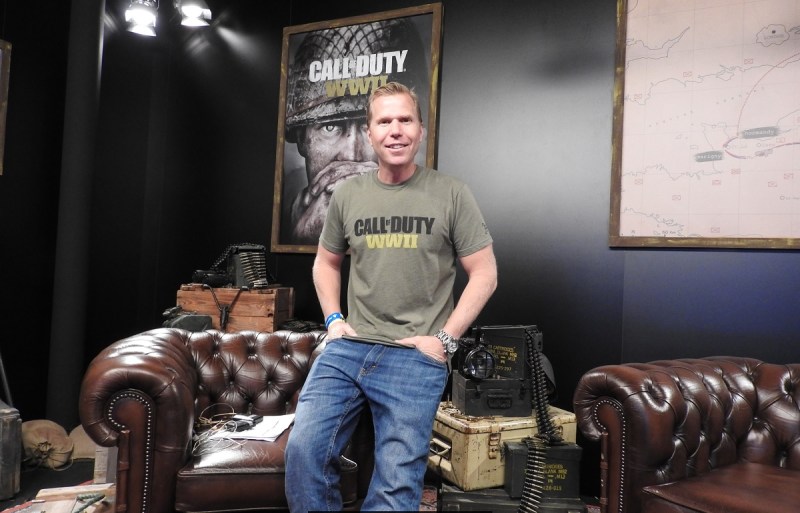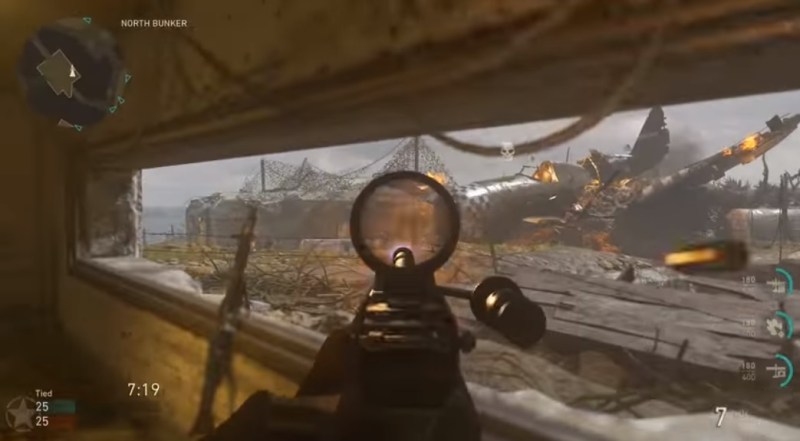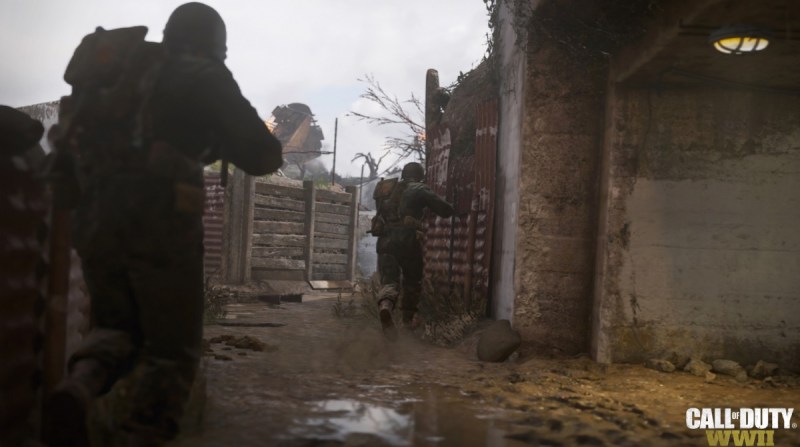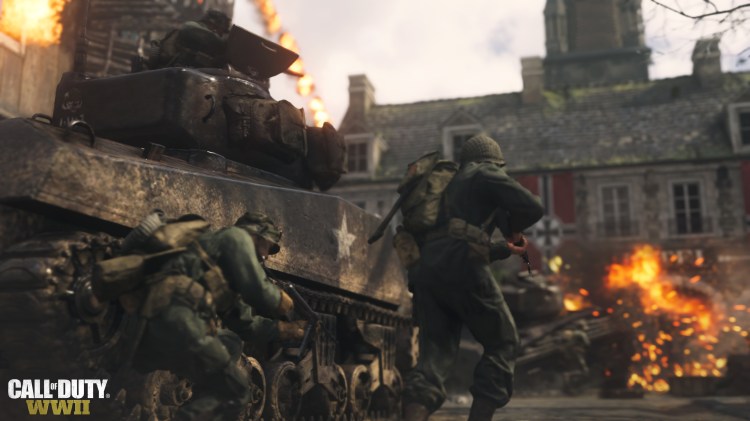Multiplayer combat in Call of Duty games has never been that social. You shoot the other players, or perhaps insult them in voice chat, and move on to the next game. But with Call of Duty: WWII, developer Sledgehammer Games designed the experience to be more social and memorable.
Publisher Activision and Sledgehammer showcased the Headquarters hub of WWII this week to show what it means. The Headquarters hub enables 48 players to gather in a group that spans more than just a single clan. It’s a group that can share achievements, videos, leaderboards, and compete with each other in one-on-one sessions to see who is the best at a particular skill. Even when you played in clans before, there were very few ways to communicate in the game.
Michael Condrey, co-studio head and cofounder of Sledgehammer Games in San Mateo, California, believes that the hub will lead to better engagement and closer ties that will keep players in a more fulfilling Call of Duty experience. And he believes there’s no better time for that because Call of Duty is returning to World War II combat for the first time since 2008.
I caught up with Condrey at the Call of Duty booth at Gamescom, the huge event for gamers that drew hundreds of thousands to Cologne, Germany. I played the latest multiplayer map, Gibraltar, and talked with Condrey about Headquarters.
Here’s an edited transcript of our interview.

Above: Michael Condrey, co-CEO of Sledgehammer Games, at Gamescom 2017.
Michael Condrey: Gibraltar’s history is really remarkable. Super fascinating. I really enjoyed my time there. The multiplayer takes you to a few other places. You saw one in the reveal trailer, a battle on the USS Texas in the English Channel. That’s unique. There are a couple of others we haven’t talked about yet.
Gibraltar’s fascinating. The English and the Spanish fought over Gibraltar for decades. At one point, Churchill decided he was going to fortify it, a huge endeavor to fortify the Rock. Using 1940s technology, they bored through the Rock of Gibraltar, 55 kilometers of tunnels. There was so much rock taken out of these siege tunnels that they built the airport right at the base of it. They built hospitals, barracks, kitchens, garages. It’s Swiss cheese now, full of holes, all because that strategic anchor was so important. They have a British naval base there now. It’s a big refueling center now for access to the Mediterranean. And a lot of it’s been preserved as a memorial.
GamesBeat: Did it ever see any action?
Condrey: It was bombed, and there were some naval battles, but nothing on land. It’s unique, though, because on the top of Gibraltar, they had these giant guns with a 12-mile range. North Africa is only seven miles away. They could shoot five miles into Africa. It was a huge power play to control shipping into the Mediterranean. There was a huge investment there. Gibraltar is new to the beta. We also have another map that we can’t talk about now.
GamesBeat: It’s a very tight map. It seems like it has very small areas.
Condrey: We’d call it a medium-sized map. It’s bigger than the Pointe du Hoc map, for sure. It’s good for objective gameplay like Hardpoint. It has the side flanking routes and some elevation change, which is cool. I like the elevation change, because it gives you this feeling of different ways to approach threats and threat lanes.
You’re playing with divisions now, part of the player progression, so you can see what it’s like to pick your division and your basic training.
GamesBeat: Can you swap that on the fly, or are you committing to one division?
Condrey: There are five divisions. You progress on every one of them. As you progress, you have the ability to unlock different divisions. I have a series of unlock tokens, and I can use those to create a new division or unlock basic training. Our soldier really has two fundamental choices now: what division do you want to be in and what single basic training you want to take. Unlike before, in Pick 10, which had lots of choices — we found that those two choices still allow players to craft their own play style.
I’ll unlock a new one here. It tells you what you get. The infantry there get the bayonet on the rifles. Airborne gets the suppressors. Each division has a unique skill. Let’s do expeditionary. I get a unique skin, a uniform, and I get the shotgun with incendiary shells, which do damage over time. I can add one basic training — take two primaries, or reload faster.
GamesBeat: What does “forage” there mean?
Condrey: I can pick up more ammunition from downed enemies. Each of these is a skill you can unlock as you progress, and you choose one. Your division plus your basic training skill defines your soldier. I can go in and customize. I’ll unlock different unique uniforms. This is unique to the expeditionary force, so if you see him you know where he’s from. Obviously you can go in and personalize your weapons. You can choose from a number of score streaks. Right now the beta only allows you to progress to level 20, so this is just a slice of all the new options.
GamesBeat: You’re mixed in with everybody else, right? You’re not grouped with other people in the same division.
Condrey: That’s right. It’s just Allied versus Axis. Within each side, it’ll be a makeup of different divisions. It’s great for something like our new War mode, where you’re going to want to have some guys with smoke grenades that are fast, and some mountain division guys with big LMGs. It allows you to craft a team of different people if you party up.
GamesBeat: How many maps are you expecting to launch with?
Condrey: In line with other Call of Duty games — and this doesn’t include the War maps or Headquarters — we’ll have at least 10 multiplayer maps, Zombies, campaign. It’s pretty robust.
We showed Headquarters to everybody as part of the presentation before we started. You know the concept of Headquarters, right? This has been going for six years, since the beginning of Advanced Warfare, trying to bring your character to life and really personalize yourself and bring you to the war. Now we want to give you place that’s not just the war. It’s a social place you can be rewarded. This is a piece we’re going to unveil tomorrow.
You and I, over the years, have probably had about the same kill/death ratio, game to game. Something like that allows you to really hone in on — I’m not one that gets a lot of kill streaks and things like that, but with that you’re able to practice so that when you do get it, it’s a lot more effective. There are lots of things like that that you can do to improve.

Above: War zone map in Call of Duty: WWII.
GamesBeat: Usually when I get it it’s a surprise, and then I think, “Hey, wait, I don’t know how to do this.”
Condrey: Most people have that experience, right? Even Brian and I, we’re pretty good, but every new year you get a score streak and you think, “What is this? How am I supposed to use it?” Then you’ve wasted it. But you can go in and practice things like the turret gunner, one of the really high-end ones, similar to the chopper gunner in Black Ops II.
The cool thing for us is, we know that a whole bunch of players just want to be social and do things that aren’t gun-on-gun action. You can hang out and be social. You can party up. You can customize your guys. You can go play Zombies from Headquarters.

Above: Pointe Du Hoc action in Call of Duty: WWII.
GamesBeat: Did you pick some of these ideas up from Call of Duty Elite?
Condrey: No, it came more from — I really love the cities in World of Warcraft. You go on all these quests and you come back to the cities and you see people just being organically social, hanging out, showing off, trading. People would ride in on their epic mount and you’d think, “Whoa, who’s that guy?” They’d mail each other to meet at the auction house. All these things formed the community aspect around this large social space. It’s something Call of Duty hasn’t had before.
We know there are people who want to be with their friends, who maybe don’t want to play competitive Team Deathmatch or Domination as much, but they want to go and master the emblem editor. There are leaderboards for all kinds of things. There’s a social score. Unlike your K/D—we want to change people’s behaviors. In Headquarters, the more things you do to contribute to the community, the higher your social score, and the more rewards you get. At some point we hope to see people asking, “Hey, what’s your social score?” instead of asking about K/D, because it means you’re just an awesome member of the community.
GamesBeat: Are you able to learn better because you’re fighting against humans in that social area?
Condrey: The 1v1 is player-versus-player. The competitive firing range, you’re playing against other players.
GamesBeat: So in some ways it’s better than a tutorial that just pits you against bots.
Condrey: Right. At the studio, Brian and I and a bunch of other guys will jump on the firing range and see who can get the most shots, the highest accuracy. That spirit of social competition is part of Call of Duty. You can get up to 48 people simultaneously in the firing range. It’s cool. We know a lot of players want to come together and experience it in different ways. Organic things start to happen. People start hanging out. There are little Easter eggs to find, different ways to express yourself. All that comes together. We end up with a pretty neat space, the first true social space for the franchise.
GamesBeat: Is there a theory that that makes the game stickier, so people come back more generally? The time spent in the whole game increases.
Condrey: A couple of things are important. One, you want your experience to end on high notes. When I think about the types of activities I enjoy — I’ve grown up with brothers. I was in a fraternity. I enjoy the competitive spirit of things like fantasy football or pickup basketball. But I also like hanging out with my friends and just having a social space.
I don’t want the last experience of your night to be just looking at your latest K/D. I want you to be able to go somewhere and enjoy being part of the community. You can celebrate and have some fanfare. Prestiging is a great example. You’ll spend nearly 30 hours to prestige, and right now, there’s no fanfare. You don’t do anything with your friends. You just go home and press X. But now, with Headquarters, you prestige in front of the whole community. It’s a big celebration. Fireworks go off. The general comes out and congratulates you. It’s a high moment. That’s proper fanfare.
That and this idea that if we can drive a new type of behavior, this social score that inspires people to work together in the community — yeah, you’ll come and hang out for a few minutes and party up. Maybe you’ll jump into Zombies, come back and jump into MP, come back and show off some emblems you created, or head down to the firing range. It’s a bunch of things that will change how you want to play and what brings you back.
For new players, we’ve all known—it’s no secret that when you play Call of Duty for the first time as a new player, you can be intimidated. You’re not really sure how to become proficient. Maybe you start on the firing range. We have this great onboarding now, the first time you start in Headquarters, where it teaches you about the game. It sends you on some missions to get experience. As that all comes together—we hope players will find a way to start their night there or end their night there.

Above: Call of Duty: WWII
GamesBeat: Did you think about adding spectating? That happens a lot outside the game on Twitch now. There’s a bit of watching 1v1s going on now.
Condrey: Yeah, there is. We know people like to be recognized for doing well. Headquarters is full of leaderboards. Every Headquarters has 48 players and there will be many instances of them around. Each one will have leaderboards for all the people in that community. You’ll know if you’re the best at TDM, or if you have the best accuracy on the firing range, or the most kills in 1v1, or the top social score. You can spectate and message. There’s a whole system of quick chats to connect and talk.
GamesBeat: Do you still do clans separately?
Condrey: Right. This is going to feel like a proper, living, interactive social space. 48 players was a stretch for us. It took a lot to get to that. The setting is D-Day plus three, three days after D-Day, where the Allies have taken the beaches and set up an operational space. It feels very full of people.
There’s a classic photo from Life or Time Magazine showing Normandy beach three days after the landing. Because the harbors had all been bombed, that became where they brought in all their operational supplies — thousands of troops and vehicles, hundreds of thousands of pounds of food and ammunition, it all came in through Normandy and they set up a base there. If you look at Headquarters now, you can see the inspiration from that photo. It’s the historical motivation. You can see it here. These were all the Allied operational forces coming in. We’re trying to capture the spirit of this massive force.
There’s a theater where you can spectate other events happening. There are recreational areas. We have a bunch of things we hope will keep people coming back.
GamesBeat: Are more of the maps smaller, on a scale like six players versus six players?
Condrey: The traditional Call of Duty maps, the small to medium designs, quick to engagement, that’s still where we find the most enjoyment as players. War mode has non-traditional layouts, though. It’s still six on six, but it’s this asymmetrical, linear experience where you push through objectives. That’s a ton of fun. It pushes teamwork in a different way. It’s a different flavor. We have several maps coming in addition to the one you saw at E3. It gives us some unique opportunities.
GamesBeat: There’s no Cologne map, right?
Condrey: No, but we’re definitely going to unveil two German maps this week at Gamescom.
GamesBeat: Have you thought about doing a Dunkirk map, now that it’s so much more famous?
Condrey: We had talked about Dunkirk and the beginning of the war. We talked about the eastern front. For now, though, it’s 1944 and 1945, D-Day to the Rhine, the Battle of the Bulge, Hurtgen Forest. There are a couple of other European locations that are not in the campaign, but they all generally take place in the European theater.
Disclosure: The organizers of Devcom paid my way to Cologne. Our coverage remains objective.

